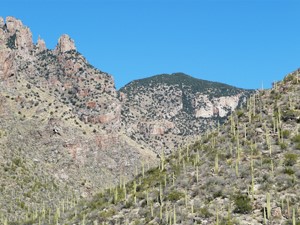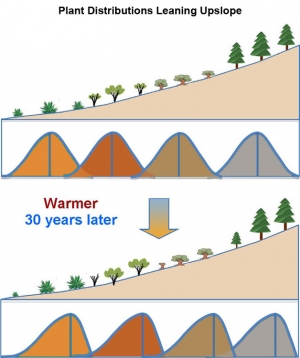Species Redistribution
Species redistribution refers to the migration of native plant species into new territory but can also be thought of as the loss of species or ecosystems from their old territories. In the Southwest, the most widespread example of species redistribution is the movement of woody plants like creosote bushes and mesquite trees into native grasslands. The spread of invasive species is also considered a form of species redistribution. These changes occur due to long-term environmental changes like climate change, short-term environmental disturbances like drought or fire, or human-induced land use changes like ranching. Research indicates species ranges are shifting on global and regional levels, towards the poles and upwards in elevation.

Figure 1. Plant distributions leaning upslope. A study by Kelly and Goulden (2008) demonstrates that the actual boundaries of plant species ranges stay the same, but the central tendencies of the plant population moved upslope over a period of 30 years. Breshears and colleagues (2008) define this movement as leaning.
| Enlarge This Figure |
Credit: David Breshears2, Terrestrial Ecology Lab, The University of Arizona
Research increasingly connects species redistribution to climate variability and change mainly by looking at:
- Observed vegetation responses
- Past responses from fossil records
- Future modeling and projections
Observed Vegetation Responses
Projected climate changes for the U.S. Southwest include rising temperatures and decreased precipitation, which could cause a redistribution of grassland, woodland, and desert ecosystems. Cold temperatures limit plant growth in higher elevations and latitudes, while the limiting factor in lower, warmer elevations and latitudes is a low level of soil moisture. Vegetation boundaries remain stable as long as resources (water and nutrients) and temperatures remain within a tolerable range. If resource availability or temperatures extend beyond this range, the boundary becomes unstable, allowing one species to outcompete another, thereby shifting the range boundaries for both ecosystems. Climate change will affect resource availability, causing boundary movement between species and ecosystems. With increased temperature and aridity, some plants may encroach into cooler, wetter territories, while others may simply die-off.
Globally, plant species are migrating towards the poles at an average of 20 feet per decade. The creosote bush, found in the Chihuahuan Desert of northern Mexico, Texas, and New Mexico, provides one example of northward migration in the Southwest. The species’ maximum northern range marks the transition from desert to semi-arid grassland in the central Rio Grande Valley in New Mexico, south of Albuquerque. Currently, the range of creosote bush is moving northward up the central Rio Grande Valley in New Mexico.

Credit: Gigi Owen, CLIMAS, The University of Arizona
From the lowest elevation up to around 4000 feet, the desert ecosystem houses saguaro cactus, creosote, and other small shrubs and cacti. The next elevation zone, up to around 5500 feet, is comprised of grasses, shindaggers, sotol and some small live oak trees. Above this elevation, live oaks, alligator juniper trees, and ponderosa and pinyon pine trees make up the dominant vegetation. The top of Mount Kimball at 7258 feet is considered a sky island.
In the Southwest, species redistribution includes both the advancement of grasslands into adjacent deserts or woodlands and the expansion of deserts into adjacent grasslands or woodlands. Woody plant encroachment has occurred for decades in the region but the cause of this movement is a topic of debate. Some researchers claim it is due to increased livestock grazing or changes in fire control. Other studies suggest that increased atmospheric carbon dioxide since the Industrial Revolution has caused the increased woody plant encroachment.
Species are also migrating upwards in elevation. Researchers Anne Kelly and Michael Goulden at the University of California, Irvine found the average elevation of dominant plant species rose by 6.5 meters over three decades by 2007 in southern California. David Breshears, a researcher at the University of Arizona, and colleagues have defined different types of redistribution along an elevational gradient as leaning—when the range stays the same but the central population shifts higher; marching—when the entire distribution moves upslope; or crashing—when a major portion of the range dies off. In the case of Kelly and Goulden’s study, the actual vegetation range remained the same, but the distribution of dominant plant species moved upslope (see Figure 1).
Vegetation zones are arranged based on altitude and moisture levels in the Southwest, with desert ecosystems at the lowest elevations, followed by grasslands, woodlands, and forests as elevation increases (see Figure 2). South of the Colorado Plateau, pine, fir, and spruce forests are often relegated to “sky islands,” located on individual mountains and ranges at elevations of 7,000 to 11,000 feet. Sky island communities are isolated from one another and from the surrounding desert and grassland ecosystems, making plant and animal populations in these areas especially vulnerable to local extinction.
David Bertelsen, a Tucson, Arizona resident and citizen scientist, has documented changes in the Catalina Mountains along Finger Rock Trail for the past 20 years. His observations indicate that more than 15 percent of the species now bloom at higher elevations than when he started hiking the trail. This could be caused by regional temperature rises over the past few years.
Modeled predictions
Researchers develop future species redistribution scenarios based on global climate model outputs. These scenarios show range expansions and contractions for different vegetation types. Globally, climate scenarios show forests shifting northward into non-forested areas and up toward the tops of mountains. The extent and pattern of redistribution will largely depend on the direct effects of elevated carbon dioxide levels, which effect how plants use and store water. Higher carbon dioxide concentrations can encourage the growth of some plants, especially woody ones. The interactions between vegetation and increased temperature, aridity, and carbon dioxide levels make it difficult to pinpoint exactly how regional landscapes will change.
References
-
Parmesan, C. and G. Yohe. 2003. A globally coherent fingerprint of climate change impacts across natural systems. Nature, 421:37-42.
-
Breshears, D., et al. 2008. Vegetation synchronously leans upslope as climate warms. PNAS, 105(33): 11591-11592.
-
Crimmins, T., M. Crimmins, D. Bertelsen and J. Balmat. 2008. Relationships between alpha diversity of plant species in bloom and climatic variables across an elevation gradient. International Journal of Biometeorology, 52:353-366.
-
Betancourt, J. 1996. Long- and short-term climate influences on southwestern shrublands. In Barrow, J., E. McArthur, R. Sosebee and R. Tausch (eds), Proceedings: Shrubland ecosystem dynamics in a changing environment conference, pp. 5-9. U. S. Department of Agriculture Forest Service, Intermountain Research Station, Ogden, UT.
-
Bachelet, D., et al. 2003. Simulating past and future dynamics of natural ecosystems in the United States. Global Biogeochemical Cycles, 17:1045.
-
Neilson, R. and R. Drapek. 1998. Potentially complex biosphere responses to transient global warming. Global Change Biology, 4:505–521.
-
Archer, S. 1989. Have Southern Texas savannas been converted to woodlands in recent history? The American Naturalist, 134:545-561.
-
Burkhardt, J. and E. Tisdale. 1976. Causes of juniper invasion in Southwestern Idaho. Ecology, 57(3):472-484.
-
Polley, H., H. Mayeux, H. Johnson, and C. Tischler. 1997. Viewpoint: atmosphe
-
ric CO2, soil water and shrub/grass ratios on rangelands. Journal of Range Management, 50(3):278-284.Kelly, A. and M. Goulden. 2008. Rapid shifts in plant distribution with recent climate change. PNAS, 105(33):11823-11826.
-
Swetnam, T., C. Allen, and J. Betancourt. 1999. Applied historical ecology: using the past to manage for the future. Ecological Applications, 9(4):1189-1206.
-
Van Devender, T. and G. Spaulding. 1979. Development of vegetation and climate in the Southwestern United States. Science, 204:701-710.
-
Betancourt, J., et al. 1993. Influence of history and climate on New Mexico pinyon–juniper woodlands. In E. Aldon and D. Shaw, eds. Managing pinyon–juniper ecosystems for sustainability and social needs. General Technical Report RM-236. USDA Forest Service, Fort Collins, Colorado.
-
Mueller, E., J. Wainwright and A. Parsons. 2007. The stability of vegetation boundaries and the propagation of desertification in the American Southwest: A modeling approach. Ecological Modelling 208:91-101.

